Anti missile attack
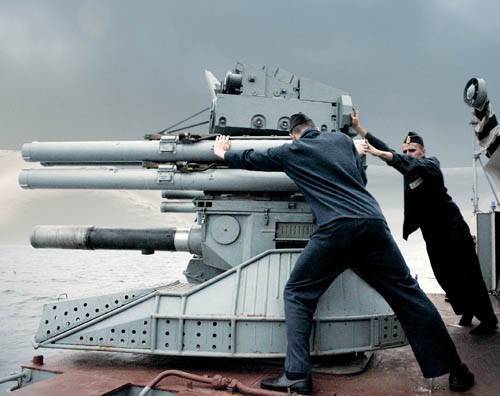
In October, the 1943 th near Yalta German bombers Yu-87 sank the leader "Kharkov" and the destroyers "Merciless" and "Able". Their anti-aircraft guns were useless against low-flying aircraft, and the 70K assault rifles had a low rate of fire and after the 80 – 100 shots they warmed up to 350 – 400С. After this battle, Stalin forbade the exit of large ships "without sufficient aviation cover." The admirals were reinsured, and until the end of the war, not a single ship from the destroyer or higher left the ports into the Black Sea.
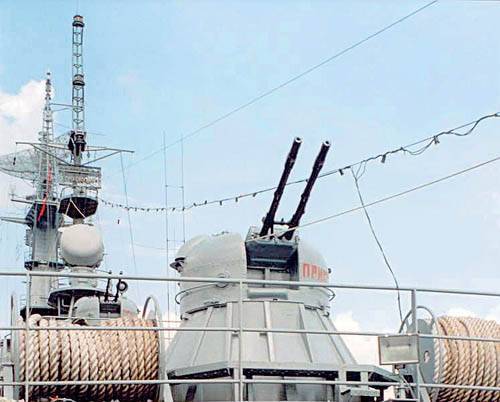
Forest trunks
American 40-mm automatic machines "Bofors" were no better than our 70K, and the Yankees decided to take a number. On their ships, wherever possible, they ran anti-aircraft guns. On the battleships of them was over a hundred, and on cruisers - up to 60, with half being 40-mm caliber, and half - 20-mm. A forest of trunks created a sea of fire. Nevertheless, the kamikaze broke through him and hit the decks and superstructures of ships. They managed to sink relatively few ships, but dozens were turned into huge bonfires, which, although they remained afloat, were only suitable for scrap.
With the advent of jet aircraft and cruise anti-ship missiles (RCC), which operated at low and ultra-low altitudes, the role of classic anti-aircraft guns has practically come to naught. The 1967 photo of the year crashed into my memory: the Egyptian MiG-17 flies over the Israeli anti-aircraft gunners, and they do not even react to it. The faces show that they do not see or hear anything.
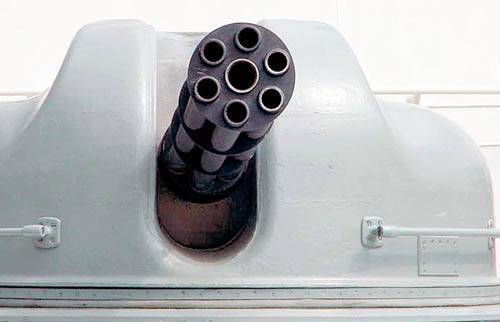
Drummers
Fully automated installations with a rate of several thousand rounds per minute were required to effectively protect the ships. In them the fire opens and is conducted without any participation of the calculation. The fire control system itself detects the target, the “friend – foe” auto-request works, the most dangerous target for the ship is selected, its trajectory and gun preemption are calculated, the barrels are guided and fire is opened automatically.
A further increase in the rate of fire is associated with almost insurmountable technological and constructive difficulties. Therefore, the designers decided to move away from the classical scheme of the “single barrel - one breech” machine gun and move on to other schemes: a revolving (drum) and with a rotating block of barrels. In such schemes there is a combination of operations that are impossible for the classical scheme.
The Soviet AK-230 two-barrel installation was created using the drum pattern. But even her maximum rate of fire was only 1000 shots / min. on the trunk, which was not enough to guarantee the defeat of a small-sized target flying at near-sonic speed. Meanwhile, in the 1982 year, one relatively small Argentine rocket “Exozet” was enough to sink the newest British frigate “Sheffield” with a displacement of 4200 t.
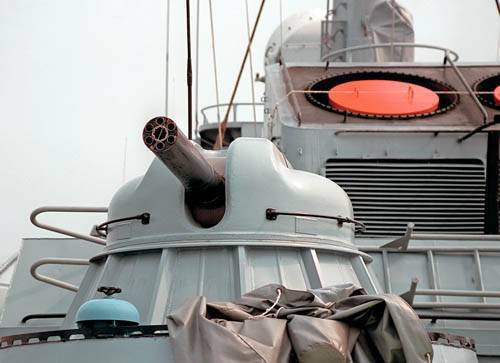
Six barrels
As a result, all the leading maritime powers set about creating self-defense systems with a rotating block of barrels.
In 1963, in the USSR, the design of the six-barreled automatic machine AO-18 (GS-6-30K) began. Six trunks, enclosed in a block, have a single automation. Characteristic feature of this weapons - continuous operation of automation in the process of firing, which is provided by a gas exhaust engine using the energy of powder gases. Food - continuous tape.
A serious problem with the rate of fire 5000 shots / min. becomes cooling shafts. Several methods of cooling were tested, including the manufacture of a special cartridge with coolant. In the final version, all methods of internal cooling of the barrel were abandoned and only external cooling was left, which occurs by sweeping water or antifreeze between the casing and the trunks.
Installation AK-630 is fully automated. Shooting is determined by the Vympel system. Here, for example, one of the options for shooting. Vympel calculates the time when the target and projectiles fired from AK-630 will be at a point remote to 4000 – 3800 meters from the ship (the maximum range of the installation in automatic mode). At the moment when fire is opened, the target may be at a distance of 5 – 6 km. Initially, shooting is carried out in short bursts of 40 shots intermittently in 3 – 5 seconds, and then, if the target is not knocked down, the installation switches to continuous fire before hitting the target. After that, it automatically begins to fire the next target.
Initially, 30-mm assault rifles were completed with high-explosive fragmentation projectiles weighing 390 g and fragmentation tracer weighing 386 in. The six-barrel 30-mm domestic AK-630 gunfire was adopted in 1980 year. AK-630 and its simplified version of the AK-306 still remain the main means of self-defense of our fleet.
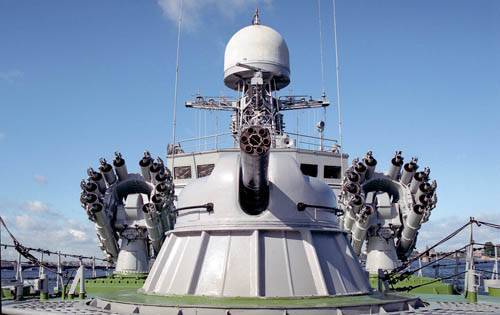
To cool the barrel, they tried to use cartridges with coolant, which evaporated when fired, not reaching the muzzle
Armor-piercing - fire!
However, firing at cruise anti-ship missiles at landfills and during local wars showed that a missile that had flown several hundred or even tens of meters to the target ship was not sufficiently damaged — it was necessary to destroy its warhead. But the combat units of many RCC armored. Therefore, abroad, ammunition of a number of shipboard automatic small-caliber installations included shots with sub-caliber armor-piercing shells. Among them are 20-mm American six-barreled artillery “Vulcan – Falanx”, 30-mm Anglo-Dutch seven-barreled “Goalkeeper” and others.
The Pryvner and Trident armored-piercing shells designed for 30-mm army 2А38, 2А42 and 2А72 automatic artillery shells were built at the PnPP. These shells are able to pierce 25-mm armor at an angle of 60 degrees from a distance of 1000 – 1500 m. Given the standardization of 30-mm shots, this sabot projectile can be easily completed and shots for marine 30-mm automata of the GSH-6-30К type.
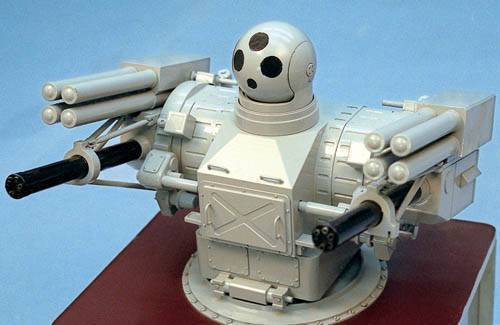
Naval automated anti-aircraft missile system "Palma", he also "Palash" is suitable for placement on ships of small displacement and boats. Two six-barreled automatic machines AO-18KD launch 10 000 projectiles per minute with an increased initial velocity of the projectile from 900 m / s to 1100 m / s.
Multiply by two
In 1970, the development of anti-ship cruise missiles flying at supersonic heights at supersonic speeds began, which should have a multi-layer warhead protected by armor and the ability to perform complex anti-aircraft maneuvers on the final trajectory. With such maneuverability, it is almost impossible to calculate the aiming point with the required accuracy, therefore, to reliably repel attacks of such missiles, it is necessary to significantly increase the rate of firing of the installation in order to create a sufficiently dense field of projectiles in the estimated “window” of the anti-ship missile. Studies conducted at KBP, NII-61 and other organizations have shown that the maximum rate of fire for a six-barreled automatic machine of the AO-18 type is 5000 rds / min. To further increase the rate of fire, there could be two ways: first, to apply new structural schemes of the machine — for example, to combine a multi-barreled scheme with a revolving, and second, to use a liquid explosive as a propellant charge, which immediately solves a number of problems, including including extraction sleeves. There were studies of telescopic ammunition, where the projectile was placed inside the sleeve, surrounded by an explosive propellant. Abroad, and we have considered other options for the design of the machine gun and ammunition. But the simplest way to increase the rate of fire was to increase the number of blocks of 30-mm trunks from one to two.
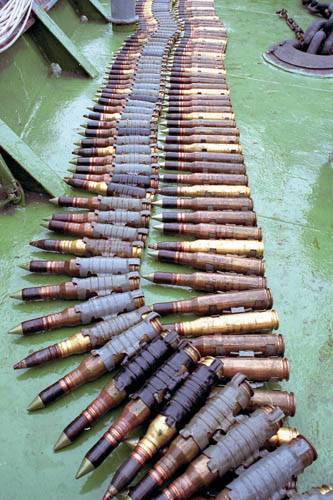 Modern systems of rapid-fire guns almost reached its limit - 5000 rounds per minute. A further increase in the rate of fire is achieved by increasing the number of artillery modules.
Modern systems of rapid-fire guns almost reached its limit - 5000 rounds per minute. A further increase in the rate of fire is achieved by increasing the number of artillery modules.In one cradle
The development of the 30-mm AK-630M1-2 two-automatic installation was launched in June of the 1983 year. The AK-630M1-2 characteristics allowed, with its adoption by the Navy, to cease production of the AK-630М, as well as to place it on the previously built ships instead of the AK-630М artillery unit, without changing ship constructions, except for mounting the second store on the 630 in AK-2000M ship barbet of the second store on the 6 cartridges. This was possible due to the rational placement of two full-time GSH-30-630K automata in the vertical plane, as well as due to the maximum possible use of parts and assemblies from AK-70М (about XNUMX%).
Aiming at the target is carried out remotely from the MP-123AM2 radar system or from the FOT optical sight station. The MP-123 / 176М2 is the upgraded MP-123 / 176 system, into which a new anti-missile mode has been introduced. The control system has KM-11-1 laser spotlights and a laser cruiser LDM-1 "Cruiser". Both machine GSH-6-30K located in the same cradle, in the lower and upper planes. The shooting mode of one machine GSH-6-30K - 6 400 bursts of shots at intervals of 5 – 6 seconds or 200 shots at intervals of 1 – 1,5.
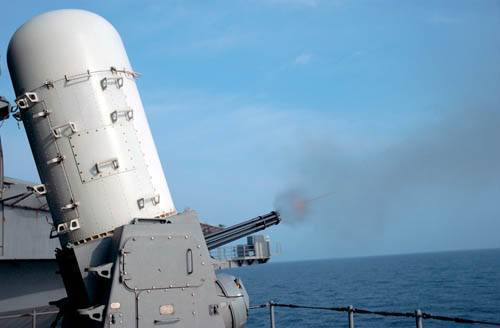
The main means of combating the American fleet against anti-ship missiles is the 20-mm Vulcan Phalanx unit of the MK.15 (USA) has a block of six barrels, the rate of fire of 4500 rds / min. Installation weight 6,18 t
Death imitators
From 19 March to 30 November 1984, the prototype AK-630М1-2, manufactured at the Tula Machine-Building Plant, passed factory tests. Subsequently, it was installed on the X-NUMX P-44 torpedo boat, the AK-206.6M being replaced with the AK-630М630-1 in the factory, not in the factory. During the shooting in the summer of 2 on the Black Sea, AK-1989М630-1 proved to be quite an effective tool. As targets were used LA-2K and ATGM "Phalanx-17", imitated RCC "Harpoon". The installation successfully hit the Phalanx, flying at a height of about ten meters, spending about two hundred shells per missile. However, the installation did not go into mass production and remained in service with only one boat.
The main reason for the failure of the AK-630М1-2 was the emergence of serious competitors - the 3М87 Kortik and Palash artillery-missile systems, which were to take the place of the AK-630М. Nevertheless, in the 1993 – 1995, AK-630М1-2 art installations were successfully advertised by various Russian export organizations.
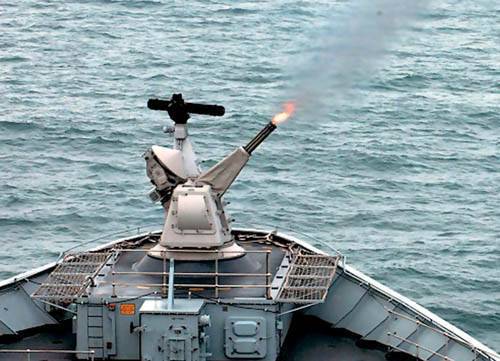
30-mm installation "Goalkeeper" (Netherlands, 1984) has seven trunks, the rate of fire 4200 shots / min. Installation weight 5,9 t
Under a pseudonym
At the end of 1970-x in the KBP under the leadership of General Designer A.G. Shipunova began work on the creation of the rocket-artillery complex "Dirk" 3М87, later received the "pseudonym" "Kashtan". Who started the fashion to come up with "pseudonyms" - remains unknown. I note only that this was not even under Stalin.
The Kortik complex is designed to hit targets with missiles at the turn from 1,5 km to 8 km, and then completed the surviving targets with 30-mm machine guns at a distance from 500 to 1500. Kortik includes one command module and from one to six combat stations. The command module consists of a radar target detection and information processing systems, distribution targeting and target designation. Combat rocket and artillery installations are equipped with its own control system consisting of a radar and television-optical channel.
The artillery part of the complex consists of two 30-mm six-barreled 6K30GSh machine guns with a total rate of fire around 10 000 shots / min., Created on the basis of the GSH-6-30К and using the same shots. Ammunition is not in the turret room, as in the early installations, but in two drums for 500 cartridges located next to the blocks of barrels. Tape feed machines replaced by auger (bezblevenevoe).
On the rotating part of the complex two blocks of four rockets are mounted, placed in cylindrical transport and launch containers. The 9М311 rocket is unified with the 2K22M “Tunguska” air defense missile complex. Semi-automatic rocket control system with radio command communication line.
The 9М311 is the only domestic ship-based missile defense system with frag-core warhead. When the warhead breaks, the rods form something like a ring of radius 5 m in a plane perpendicular to the axis of the rocket. At a distance of more than 5, the action of rods and fragments is ineffective.
The small size allows the complex to be placed on any ships, from missile boats to aircraft carriers, as well as on ground targets.
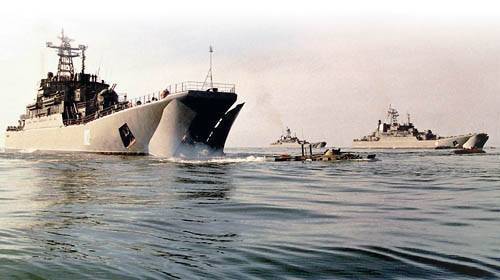
The main advantages of western competitors over domestic systems are better guidance systems, faster speed drives of guidance, as well as the use of sub-caliber projectiles capable of penetrating the armored warhead of a cruise missile and causing detonation of an explosive
Admiral with eight dirks
In service "Dirk" entered the 1989 year. Eight 3М87 modules were installed on the Admiral Kuznetsov aircraft carrier, six modules on the 1144 Admiral Nakhimov nuclear-powered cruiser, two modules were installed on two FSSs of the Fearless type 1154. By the end of 1994, the production of the Kortika ceased. Initially, it was supposed to replace most of the AK-630 artillery systems with the “Dirk” both on the ships under construction and on the ships in service, for which the ball shoulder strap and other AK-630 and 3М87 mounting parts were unified. However, on ships of a number of projects, the “Dirk” does not pass in height (2250 mm compared to 1070 mm in AK-630).
Precision Engineering
At the beginning of 1990, information about the development of the Tochmash Central Research Institute, the Palash rocket and artillery complex, also under the name Palma, was discussed. The "sword" favorably differs from the "Dirk" in half the weight and size, which allows it to be placed on ships of small displacement and boats. The rate of fire is the same as that of AK-630М1-2 and "Dirk" - 10 000 rds / min. with an increased initial velocity of the projectile from 900 m / s to 1100 m / s. In the Palash, two six-barreled automatic machines AO-18KD developed by KBP are used.
Optical electronic guidance systems of automata are located in the balloon above the setup. The system has a television and infrared channels, a laser range finder. The shooting module of the Palash complex provides for the possibility of installing eight light hypersonic Sosna P rockets, which are induced by a laser beam using a laser beam channel. In this case, the combat capabilities of the firing module doubled, the range increases to 8 km on the aircraft and to 4 km on anti-ship missiles.
In November 2005, a prototype of the Palash complex in a purely artillery version (without missiles) was delivered to Sevastopol, where by February 2006 it was installed on a P-60 rocket boat. This spring, Р-60 spent behind Cape Chersonesos, where the first shooting took place: six bursts of high-explosive fragmentation projectiles on 480. Further tests, according to the assumption of Ukrainian experts, will be held at the Feodosiya proving ground, if, of course, the Ukrainian government allows it. The main intrigue is whether the “Palash” will be able to effectively use sabot projectiles and how effective its control system is.
Information